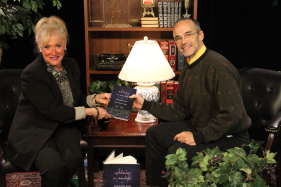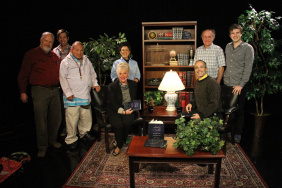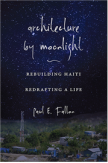Paul E. Fallon's Blog, page 80
December 25, 2014
One Hundred Years Ago Tonight
A poem by my friend, Bertrand Fay:
|
|
My name is John Wiggand
My mates, good lads all, call me Wiggers
Countrymen, my fam’ly for generations
Know the woods and fields of Hertfordshire
My Ma is gone. My Da alive, back home
Yes, and sweet Sarah, ‘less I was born t be a ghost,
She’ll be my missus when this war is done.
|
I joined up, like most, as soon as we declared
Pro Patria runs deep in me.
I know my gun, the bayonet blade, how cold steel is
So far these thirty days it’s muck and mud
That’s what it is, this bloody trench.
|
We’ll not be home for Christmas
Though they said this somber night is Christmas Eve
Anno Domini ‘14
Not what you’d call a midnight clear
Just a star or two shining down on No Man’s Land
|
And I don’t know, I might be hearing things
But across the frosted barrens a low sound comes
Like nothing you’d expect to hear.
A thrum, at first, then growing into a melody
And words, German words, Stille, heilige
Unmistakable, the tune from our side
Lad’s voices lofted on the frigid air
Silent night, holy night
And in my heart, amazement takes the place of fear
|
In the hush a wee, faint light
Another and another until I lose count
Rising ‘bove the breastwork of the Boches’ dugout opposite
As if suspended in the atmosphere a hearty glow
‘Tis then I see so many candles flick’ring on an evergreen
Tannenbaum, the Christmas tree
|
It draws us Tommies, man by man
We mount the berm, climb out from the trench
And soon sworn enemies here on the Western Front
Yet each a son away from home
Are gathered in the snowfall, smiling
Absurdly at first, then shaking hands
Clapping shoulders, exchanging what we have to share
Tobacco, oranges, a flask of schnapps
|
My harmonica, I take it from the pocket of my greatcoat
A German chap who says, in English, that his name is Franz
Is fingering a mandolin
Together we play, not quite in tune
Bach’s Jesu Joy, Bleibit meaine Freude
When we finish Franz says Wiggers, das war gut
|
Someone has a soccerball, starts a game and in the dark
We are again what we all are
Boys
Who ne’ertheless this wondrous night
Own a world where nothing seems wrong
The Great War, just begun
A Christmas truce, heav’nly peace
Midnight to dawn at first light
Strife and sorrow, more to come
But what we had ‘twas not a dream
|
December 22, 2014
Architecture by Moonlight – Reading Group Guide
 Here is a Reading Group Guide for Book Clubs who are reading Architecture by Moonlight. Enjoy!
Here is a Reading Group Guide for Book Clubs who are reading Architecture by Moonlight. Enjoy!
Architecture by Moonlight:
Rebuilding Haiti, Redrafting a Life
By Paul E. Fallon
Overview
Architecture by Moonlight chronicles author Paul E. Fallon’s journeys to Haiti after the 2010 earthquake to design and supervise construction of the Mission of Hope school and Be Like Brit orphanage. The rudimentary tasks of building in a developing country provide the context for a deeper exploration of this beguiling land, so different from the United States, yet rooted in our shared history as the Western Hemisphere’s two oldest republics.
The book reveals Paul’s personal story of balancing contradictory demands. The Gengel’s, a boisterous American family, seek to construct a memorial for their deceased daughter. Lex and Renee Edme run Mission of Hope, but their evangelical missionaries are sometimes more interested in saving souls than filling bellies or educating minds. Tradition-bound construction workers are more comfortable with magic than the physics of earthquake-resistant construction. The soul of the narrative belongs to Dieunison, a wily Haitian orphan who captures Paul’s heart and exemplifies both Haiti’s tragedy and its indomitable spirit.
From the simple yet sturdy buildings that Paul conceives, Architecture by Moonlight posits larger questions about our individual and collective response to tragedy, the act of construction as a path through grief, the benefits and pitfalls of philanthropy, and the shortcomings of international aid. By the time the two projects are complete, he envisions Haiti, unhinged from outside directives, mapping its own future.
Architecture by Moonlight is the eloquent tale of “an ensemble of incomplete people struggling in a land of great trial and great promise, trying to better understand their place on Earth.” Paul reveals how, when seemingly different people come together, we succeed by seeking our commonality. Therein lies the strength we need to rise above disaster and celebrate recovery, perseverance, and humanity.
Discussion Questions
One out of every 40 Haitians died in the earthquake; an equal number were wounded; and one in six of the survivors were homeless. Americans believe our infrastructure and technology will protect us from such a catastrophe (as it did in Chile’s February 2010 earthquake). Yet the damage inflicted by Hurricanes Katrina and Sandy were much worse than we anticipated. Can you envision a natural disaster of that scale occurring in the U.S? Would we cope better or worse than Haitians did?
Do you think Dieunison, the boy who ‘adopts’ Paul as his blan, exemplifies both Haiti’s problems and its promise? Which of his characteristics can be extrapolated to Haiti’s larger society? What aspects of Haitian culture does the book describe which Dieunison does not represent?
Paul states, “When it comes to acknowledging feelings, I am as opaque as any guy.” (page 4). At what point in the book did he move from having a vague tug toward Haiti to understanding his reason and purpose for being there?
When Paul brings a carton of children’s books to the construction site, he notices, “If a child picks up a book, his right of use is fiercely guarded, and a clawing fight breaks out if another child tries to snatch it. But once finished, the books returns to the pile, available to whoever might want it next.” (page 34). Why do the Haitian children have such a casual sense of ownership? Is it a desirable trait that fosters sharing, or reflect a lack of respect for valuable possessions? Would their attitude be different toward objects of greater immediate value, like sneakers or cellphones?
Paul comments on the simplicity and directness of Haitian Creole (page 110), a language with a limited vocabulary and no tenses, while English contains more vocabulary than any language in the world. What are the advantages and limitations of having a language or unlimited vocabulary versus one of few words?
How would Paul’s working relationships with Lex, Renee, and Len have changed if they knew his personal feelings for Lex? Should he have been more forthcoming in sharing those feelings?
Do you agree with Renee Edme’s statement, “Haiti is a country of teenagers?” Is that a positive or disparaging remark?
After Nightline visits the orphanage site, Paul reflects, “…we have all been willing fools in the dream machine.” (page 117). Does Nightline provide positive value? How could the segment be reframed to more accurately portray the project?
Paul interprets Len Gengel’s statement, “Cherylann and I have given the most anyone could to Haiti, and that’s our only daughter” (page 157) as an attempt to reframe Britney’s death to provide Len some control over it. How do you interpret Len Gengel’s statement?
Paul does not believe in pure altruism; he purports that every good deed is motivated by some self-interest, however defined. He is often frustrated by the Evangelical missionaries’ conversion agendas. But how different are their actions from the personal agendas that the Gengel’s, and even Paul, bring to Haiti?
Do you agree with Paul’s statement on page 120: “I don’t really believe humans seek peace and light, or we would make more of it on this earth.”?
Are W.B. Seabrook’s words, written in the 1920’s, “…our attitude now in Haiti is superior, but kindly” (page 161) still applicable? Is it an appropriate attitude? If not, how should we consider our Haitian neighbors?
There have been many commentaries about whether the international aid that flowed into Haiti after the 2010 earthquake was appropriate or effective. The book raises these issues in only a tangential way. (“All this aid is making someone rich.” page 163). Is this story enhanced or compromised by remaining apart from the details of politics and policy?
Architecture by Moonlight does not provide a blueprint for how to improve Haiti. It extrapolates from two specific projects to suggest broad approaches to enhancing Haiti’s participation in the 21st century. Would the book be more successful by offering more concrete suggestions? Does reading this book give you have specific ideas of how Haitians could improve their conditions?
Author Biography
Paul E. Fallon is an architect whose career focused on design of hospitals and medical institutions. Architecture by Moonlight, a memoir of reconstruction in Haiti after the 2010 earthquake, addresses design and construction at a more intimate scale. The book evolved from blog posts (www.theawkwardpose.com) written as a means to comprehend his experience on the Magic Island. Paul has written for The Boston Globe Magazine and Christian Science Monitor and is a regular contributor to WBUR Cognoscenti. He is an MIT alumnus, father of two grown children, and lives in Cambridge, MA.

December 19, 2014
30,000 Years Lost, 20 Years Found
 Twenty years ago this month, archeologists discovered Cave de Chauvet Pont d’Arc in southern France, with paintings more than 30,000 years old. Scientists from around the world have digitally mapped the cave, built raised walkways above its floor, and established protocols that limit access to 12 people for eight hours during two 15-day periods each year. These constraints are designed to minimize man’s effect on the site, while accommodating our human itch to explore and comprehend. We cannot know with certainty how our interactions affect a cave that was sealed for thousands of years – there’s no sister cave we can submit to double-blind testing. But I fear these safeguards are an illusion that salves our conscious while enabling us to poke around. Humans cannot simply leave something alone.
Twenty years ago this month, archeologists discovered Cave de Chauvet Pont d’Arc in southern France, with paintings more than 30,000 years old. Scientists from around the world have digitally mapped the cave, built raised walkways above its floor, and established protocols that limit access to 12 people for eight hours during two 15-day periods each year. These constraints are designed to minimize man’s effect on the site, while accommodating our human itch to explore and comprehend. We cannot know with certainty how our interactions affect a cave that was sealed for thousands of years – there’s no sister cave we can submit to double-blind testing. But I fear these safeguards are an illusion that salves our conscious while enabling us to poke around. Humans cannot simply leave something alone.
[image error]Werner Herzog filmed “Cave of Forgotten Dreams” during one research cycle. The 2010 film begins with a sweeping view of Pont d’Arc, leads into the cave, and alternates between illuminating the remarkable images and describing ongoing research taking place there. By film’s end, we understand these paintings through a dual lens: as extraordinary ancestral art, and an exquisite demonstration of our scientific ability to reconstruct the past.
[image error]Julien Monney, an archeologist in the film relates the story of a 1970’s Australian aborigine; a man who’s my contemporary age-wise, but the Chauvet Cave painters’ kin in his habits. When the aborigine encounters a faded rock painting, he mixes pigment and rejuvenates it. To him, the painted rock is not a fixed entity with a unique author. It’s a human contribution to the natural world that can deteriorate and be refreshed within nature’s rhythm.
Our response to the paintings at Chauvet has been exactly opposite. Through the researchers interventions, we preserve the cave floor we deem valuable, while violating other areas by erecting a walkway. We collect and analyze charcoal fragments. We chip away and stabilize, but we do not contribute, add or embellish.
[image error]Dominique Baffier, Curator of Chauvet Cave, explains what she considers important research findings. She attributes a pattern of red dots on a prominent rock to one specific man, six feet tall with a distinctive thumbprint, yet determines that other paintings contain elements that span five thousand years. A five thousand year timeframe is akin to me, in 2014, contributing stone to an ancient ziggurat.
[image error]The cave paintings resemble contemporary compositions. Horses with multiple legs and a female pelvis embracing a bull’s head are Picasso and Duchamp’s spare, elegant forebears. I’ll never see them in person, and I never should. But, thanks to the digital age, I can appreciate them through Mr. Herzog’s film, 3-D mappings or the replica constructed a few miles from the cave.
I don’t understand the film’s title, Cave of Forgotten Dreams. The cave is not forgotten – it’s found. And forgotten dreams are not accessible to our consciousness, while we’ve spent twenty years applying scientific ‘how’ and ‘what’ to scratch at the spiritual question that plagues us: why.
[image error]The true cave of forgotten dreams is yet undiscovered. Once found, it will be subjected to the fashionable human prodding’s of that time. If Chauvet Cave had been pried open 5,000 years ago, it might have provided shelter; 500 years ago, an opportunity for plunder; five decades ago, a bonanza for tourism. Instead, the cave was found during a period fixed on preserving and replicating. We revere ancestors by freezing them in time. We coopt them by recreating their 30,000-year-old sanctuary in three years. Are our preservation efforts a tribute to our ancestors, or do we set ourselves above them by refusing to contribute to their collective expression?
We are also left to ponder Herzog’s central question: What is time? We’ve known these paintings for less than one-one-thousandth of their existence. We determine that they’re ancient, yet consider them new because we measure existence from discovery. What is time when more than a thousand generations lapsed between Chauvet Cave ancestors and us, yet aborigine cousins touch up similar paintings in our lifetime? Why do we care that a single man painted red dots while other compositions evolved over millennia? Are our preservation efforts a tribute to our ancestors, or do we set ourselves above them by refusing to contribute to their collective expression?
[image error]My gut response to research in the Cave de Chauvet Pont d’Arc is to cease our meddling and seal it back up. But we cannot pretend the cave away; it is found, and humans are compelled to explore. Our constant push to achieve, obtain and understand drives progress. That’s why we dominate this planet, even to the point of endangering its natural balance.
What bothers me is our pretension of preservation. Cave de Chauvet Pont d’Arc is a phenomenal example of early man’s capabilities. Our analytical bent and technical prowess dictate that we study it rather than add our hand to it. But we’re only kidding ourselves in believing that our walkways and lasers and simple presence don’t alter this remarkable place. We make our mark by keeping our hands off, but future generations will know we were here.
____________
This essay was published December 18, 2014 by WBUR Cognoscenti under the title: “Ancient Cave Drawings, Modern Science, and the Pretense of Preservation”.

December 14, 2014
Return to Haiti: Saint Boniface Hospital Infectious Disease Pavilion
[image error]I am off to Haiti early Monday morning, taking a familiar trip that I haven’t made in over a year. I’ll be traveling with Conor Shapiro, Executive Director of Saint Boniface Hospital in Fond des Blancs, the largest hospital in Haiti’s southern peninsula, and acute care center for children from Be Like Brit orphanage and Mission of Hope School.
I’ve been working with Conor and others from Saint Boniface for several months designing a TB and infectious disease pavilion as well as an expansion of the their emergency department / operating suite. We received funding from USAID for the infectious disease pavilion, and so are making a site visit to coordinate design details with site conditions and local clinicians. We hope the ED/OR expansion will be funded soon.
[image error]This is an exciting project that will offer improved health care for the two million people in the southern peninsula. But it also represents the changing face of design and construction in Haiti – at least in my personal experience.
These projects, funded by international aid agencies rather than local initiatives, are organized along the lines of design and construction we have in the United States. I’ll develop the design, but won’t be doing direct construction work as I did in my projects after the earthquake; there are local and American construction teams for that. This reflects more sophisticated project delivery for Haiti, but less hands-on work for me.
[image error]I am also going to have two days in Grand Goave; a chance to visit Dieunison and Dieurie and other friends there. Fortunately, Lex and Renee have a list of things for me to do. They know how I hate to just sit around visiting. I love Haiti, but I lack the social gene so common among Haitians.

December 11, 2014
Seeking Fives from a Machine that Spits Twenties and Hundreds
[image error]I needed a bunch of fives and tens to make change for a yard sale. My local Bank of America had closed, replaced by a new Express Banking Center down the road. A cheerful woman in a tailored suit greeted me as I walked in. One shiny red wall boasted two ATM’s plus two clunky protrusions jutting into the lobby at counter height. I withdrew $200 from the ATM and received ten $20 bills, as I expected. I walked to the reception desk and asked a second woman if I could get change.
“We don’t have any money in this bank, except what’s in the machines.” She pointed to the bigger machines. “If you use the remote teller, it can distribute fives and tens.”
[image error]I followed instructions to make a withdrawal from the cantilevered machine. I anticipated a screen command to request my preferred denominations, but it never displayed. Out came five twenties and a hundred dollar bill. Now I had four hundred dollars but no small bills. I returned to the woman at the counter.
“You have to talk with the remote teller. He or she can distribute smaller bills.”
“You might have told me that before I took out another $200.” My voice must have notched up, because a third woman emerged from the back, eyeing me as a problem customer. Now, the counter woman rose from her chair and escorted me to the machine. I pushed the remote teller button and told the smiling face I wanted five and tens. He explained only fives were available. Fine by me.
I added forty, five-dollar bills to the stack already in my hand and a trio of electronic receipts. The three gracious women eyed me from arms distance.
“Can I get you an envelope for all that cash?”
“No”, I replied, stuffing it into my wallet, now too fat to fold.
“You can redeposit the extra cash you took out.”
At that moment, I was more inclined to remove all my money from Bank of America rather than give any back. I certainly didn’t want to confront another machine. “In the future, better customer service would be to explain how the machine works before people make unwanted withdrawals.”
The woman smiled robotically, but didn’t apologize or acknowledge any value in my comment.
When I leave the bank with money in my pocket I usually feel rich, light-footed and flush. This time, my engorged wallet weighed me down, stuffed but unsatisfied.
Yet how unsatisfying it must be for the three women standing in that pristine, so-called bank. Cashiers with no cash, relegated to directing customers to a disembodied head for simple transactions. Transactions they could surely perform themselves, if only Bank of America would let them.
Who is being served in this machine-centric facility staffed by humans neutered of their purpose? I do most of my banking electronically, but when I need a teller I want a live person, not a face on a screen. Although they might have offered better direction, I felt sorry for the attendants, vestige ornaments of a time when humans actually performed functions rather than loitering in service to the machine.
[image error]Maybe my Express Bank is more secure for Bank of America. Maybe it’s more accurate than having human tellers with pesky cash drawers. I can foresee that once the new ‘bank’ is open for some time the three staff people will be reduced two then one, and eventually the facility will operate without any human interface.
POSTSCRIPT
The next day I received a survey from Bank of America about my experience at their new Express Banking Center. It included ten specific questions about my interaction with the machine. Not a single query about my experience with the actual people they employed in that space.

December 8, 2014
Yoga: Practice and Teach
I have two regular teaching yoga gigs!
[image error]Every Tuesday night at the Cambridge YMCA I teach 75 minutes of Form and Flow. The class is free to YMCA members, but my guests can come for $10, and use the rest of the facilities as well.
Alternating Sundays, starting December 14, and continuing January 4, January 18… I am teaching a 90-minute men’s vinyasa class. This by-invitation-only group was where I took my first yoga class almost ten years ago! Most of the practitioners are middle-aged men, though men of any age and condition. Spoiler alert: a naturist founded this group; we practice naked. If this sounds erotic, it isn’t. However, it really helps practitioners to align their body.
I am still a[image error]s novice as a teacher, finding my own voice, as they say. I lack the confidence of people who’ve been teaching ten, even twenty years; and the certitude of teachers who adhere to a particular discipline. I find that teaching enhances my own practice – I concentrate on the particulars and logistics of the classes I take in a fresh way. And the feedback I get from students reinforces that my teaching – very structured and high energy, like me – is improving all the time, as I find it easier to align my class with the yoga experience in the studio.
If you’re interested in coming to a YMCA class, contact me at fallonpaule@gmail.com. If you’re interested in the Sunday men’s group, contact Bob Sparling at yoga4men@comcast.net.

December 4, 2014
10 Gay Sensibilities on Parade Over Thanksgiving Weekend
[image error]Over the four day Thanksgiving weekend I recognized gay sensibilities integrated into every aspect of our culture. After six decades on this planet, I’m thankful that, for many of us, being gay in America allows our fullest expression. My dream for next Thanksgiving is that everyone can enjoy such latitude.
[image error]1. High Kicks and Show Tunes. The Macy’s Day Parade plays on the television while I put the turkey in the oven. I stop basting to watch Broadway snippets by Tony Danza (really?), Idina Menzel, and the Rockettes kick line. Love those silver shoes.
[image error]2. Grandmother’s Dishes. My housemate and I have a cupboard full of china and silver that none of our siblings wanted. Our Thanksgiving table sparkles with crystal candlesticks, flower embellished china, and curlicued silver. We use the Greek motif set for dessert.
[image error]3. Mix and Match. Hosting Boys in the Band style all-male events is passé. Three gay men join us for dinner, along with a pair of female friends and a few straight guys. What none of us share are blood relations – everyone at our Thanksgiving feast is a transplant from somewhere else.
[image error]4. Let Them Eat Cake. The ethos of the skinny gay guy is kaput. We are as thin and fat, grey and gravity worn as everybody else. Seven pies and a gigantic red velvet cake spread across our Thanksgiving dessert buffet. We indulge in every one of them.
[image error]5. Antiquated Homoeroticism. On Friday I take in Foxcatcher. Channing Tatum’s lumbering, inarticulate jock reminds me of guys I admired and feared in high school. Steve Carell’s creepy John DuPont makes me squirm; I recall inhabiting skin that provides no comfort. The erotic dissonance of their wrestling relationship is palpable, but dated as Mark Ruffalo’s aviator glasses.
[image error]6. Yoga Sculpt. Saturday morning I take my usual yoga sculpt class. I lay my mat before the front mirror, wear only skimpy compression shorts, pump the heaviest hand weights, and drench my towel in sweat. The thirty young Lululemon women arrayed behind me are accustomed to my deep squats in their midst.
[image error]7. Sing Along Time. Saturday afternoon, two friends and I invade the balcony of an old vaudeville theater for the Mary Poppins Sing-Along; the only grownups without a toddler in tow. Then again, no one is really at grownup on a jolly holiday with Mary. I tear when the family runs off to fly kites while Julie Andrews rises to the clouds.
[image error]8. Liberal Guilt Trip. On Saturday night my housemate and I attend Eve Ensler’s new play, O.P.C., at the A.R.T. Less a play than a polemic; it suffers from too many judgments against a world of too much trash. When the lights come up we shake our heads among the middle-aged couples who wonder what we did to deserve such a scold. Eve needs to learn that a spoonful of sugar helps the medicine go down.
[image error]9. Gym with Guys. Sunday afternoon is Gold’s Gym time – stretching and a triceps workout followed by twenty minutes of cardio. Unlike yoga women who exercise toward the back of the studio, gym boys strut and pose in front of their mirrors. I run my paces on the treadmill with the best view of the free-weight floor and enjoy their grunts and presses as much as they do.
[image error]10. NFL Time. I wind up my weekend like most Americans – watching football with buds: Patriots versus Green Bay. True, we have hors d’oeuvres rather than chips, wine as well as beer, and spend as much time analyzing physiques as play action. But when the Pats go down 26-21, we’re just as despondent as any fans.
With so many gay sensibilities infiltrating our society, I can foresee a time when so-called ‘gay sensibilities’ will disappear. Being who we are without wearing a gay label is not a loss I fear; it’s a dream I embrace.

December 1, 2014
Past Peak
 Fall foliage peaks around these parts in October, when hillsides display New England’s calendar splendor; giant arcs of brilliant red and orange leaves holding firm to their branches. But I prefer November’s starker beauty, when more leaves lie underfoot than hang overhead. The stragglers still clinging to their life-source are too few, too fragile, too sallow to conceal the dark trunks and branches silhouetted against the slanting sun. They remind me of myself: past prime and, by most economic measures, practically past purpose. Yet, in their diminished form and number, these leaves reflect autumn’s weak light with greater dazzle. They are also all that stand between us and full-on winter.
Fall foliage peaks around these parts in October, when hillsides display New England’s calendar splendor; giant arcs of brilliant red and orange leaves holding firm to their branches. But I prefer November’s starker beauty, when more leaves lie underfoot than hang overhead. The stragglers still clinging to their life-source are too few, too fragile, too sallow to conceal the dark trunks and branches silhouetted against the slanting sun. They remind me of myself: past prime and, by most economic measures, practically past purpose. Yet, in their diminished form and number, these leaves reflect autumn’s weak light with greater dazzle. They are also all that stand between us and full-on winter.
[image error]I am not old; it will be years before I’m the gaunt silhouette of a winter human. I’m middle-aged; a term that our youth-obsessed culture only applies when our middle years have, in fact, already passed.
Just as global warming pushes peak foliage deeper into autumn, so too our longer life spans change our perceptions of age and time. I grew up in the era when we distrusted anyone over the age of thirty; everything worthwhile belonged to the young. A recent survey reports that we don’t achieve optimal happiness until the age of 33. But the reality of aging is more complex than a single year can connote. The Atlantic Monthly reveals the magic of the U-Curve, while Britain’s Daily Mail contends that happiness dips in our thirties and forties, only to tick up from age 50 and peak at age 85!
I’ve never laughed as long or hard as I did during my teens and twenties, but I prefer the more balanced happiness – call it contentment – that arrived in my forties and fifties. Most of my friends are in their sixties; soon, I’ll join their ranks.
We still talk about big[image error] issues: the state of our economy, the direction of our nation, the health of our planet. But our personal health demands more discussion, dissection and diagnosis than before. Traditional career satisfactions are behind us; we’ve either retired or moved into holding patterns pending Social Security. We speak in the past tense more than in the future one. A decade ago, we juggled careers and children and aging parents. Now, our parents are deceased; our children are grown; our grandchildren have yet to arrive. As those immediate demands diminished, then evaporated, life became more leisurely, open-ended and satisfying.
It’s been almost a year since I left paid-work. My son was the first person to label me retired, but I’ve come to embrace the word. Freed from pursing a paycheck, I’ve published a book, become a yoga teacher, taken up massage, joined a gym and tutored immigrants. I have the time to visit any friend who lands in the hospital, but I can relax into a novel whenever the urge strikes me.
I’m not as actively engaged in the world as when I battled downtown traffic every day and lent my hand to designing hospitals. Six hours of sleep was the norm then. These days, I always get seven or eight, sometimes 10.
[image error]I am like that November leaf[, depleted of the chlorophyll that once made it verdant, but full of carotene, the less robust but more stable pigment in yellow leaves. My contributions, like the faded leaf, are subtler than during the mid-summer of my life, but they are more gentle and personal, too. A golden leaf dangles from its withered stem. The sun shines upon it, and I feel splendid in its fleeting light.
________
This essay was originally published in WBUR Cognoscenti titled ‘A Starker Beauty: Embracing the Autumn of One’s Life’, on November 29, 2014.

November 27, 2014
Giving Thanks for the Unexpected
[image error]Of the many, many things I have to be thankful for today, Dieunison stands out as the most unexpected blessing in my life. When he adopted me in 2010 I could not have realized how much he would personify everything fantastic and tragic about Haiti. He became the narrative thread of my Haitian adventure described in Architecture by Moonlight and its most popular character. He’s captivated readers of Boston Globe Magazine and was the featured essay this month on Medium. Today he and his brother Dieurie are heads taller than when I first met them, live in a secure house, have regular meals and education (thank you, Lex and Renee Edme and everyone at Mission of Hope). They may be awkward 13 and 14 teenagers still grappling with third and fourth grade, but their opportunities have never been brighter.
Fortunately, none of these ‘improvements’ have altered Dieunison’s fundamental character – he is still a mischievous cut-up and natural heart breaker. He charms and confounds everyone who crosses his path. Dieunison recently captivated Sean Collins, a Mission of Hope volunteer, with a studious side I have never seen yet always knew existed within his clever spirit. Using yet another derivative spelling of this chameleon’s name, Sean writes in his blog:
[image error]Some of the kids have definitely been a big inspiration too. With the class of younger kids most of them just want to play math games and take pictures. But one kid in particular is too fascinated by the world around him to be caught up in that sort of mindless entertainment. Dionson (pronounced Jenson) is a 13 year old boy whose bright mind and thirst for knowledge has truly amazed me. All class he sits and reads the French Wikipedia pages. He’s on a new topic every day and never stops asking questions. Together we’ve explored sounds, light, the stars, the planets, force, and a few other aspects of the natural world. After the second day of class he begged me to let him keep the laptop out a little longer. I of course said yes and he went with me to the room where I charge the laptops. A few minutes later one of his friends appeared and asked if he could use a laptop. I told him he could only use one if he used it to read. He agreed to my terms and booted up his own machine. After about 30 minutes I had a group of 5 all laying on the carpet eagerly exploring Wikipedia. Dionson is a brilliant young mind and I hope the other kids continue to follow in his footsteps.
I never take for granted the many gifts in my life. But Dieunison infiltrated my soul so unexpectedly he is a unique gift. I have promised him and his brother Dieurie that when they graduate high school, I will bring them to visit the United States. That is years away, but I can already envision what joyful chaos he will create at our Thanksgiving feast.
[image error]Dieunison and his brother Dieurie

November 24, 2014
NewTV: Three Lessons Learned
 Last week I had my first TV studio experience. BJ Krintzman, Newton lawyer, mega-blonde and overall fabulous person, interviewed me on her long running cable television show, “That’s the Law”. I was hard pressed to figure what Architecture by Moonlight had to do with the law, but BJ made a clever connection, which led us into a fascinating discussion of Haiti. BJ made some other fresh observations: describing the book as “A Year in Provence meets Three Cups of Tea.” Watch the interview here.
Last week I had my first TV studio experience. BJ Krintzman, Newton lawyer, mega-blonde and overall fabulous person, interviewed me on her long running cable television show, “That’s the Law”. I was hard pressed to figure what Architecture by Moonlight had to do with the law, but BJ made a clever connection, which led us into a fascinating discussion of Haiti. BJ made some other fresh observations: describing the book as “A Year in Provence meets Three Cups of Tea.” Watch the interview here.
Three things I learned from my adventure in television:
 1. Studios are wicked cold. I was glad I wore a sweater.
1. Studios are wicked cold. I was glad I wore a sweater.
2. You can’t see a thing beyond the bright lights, except these flashing time signs that pop up with ten minute, five minutes, one minute left that burn into your brain and make you want to talk faster.
3. When you see hosts and guests chatting during the credits, we’re not actually saying anything. BJ just told me to fake blather.
 Thanks to BJ and her great crew for interviewing me. I am all ready for John Stewart. Why hasn’t he called yet?
Thanks to BJ and her great crew for interviewing me. I am all ready for John Stewart. Why hasn’t he called yet?









